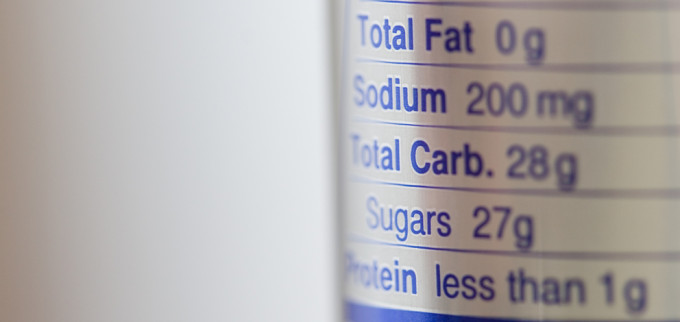And so, once again, the dialogue on health and diet is stringently focused on nutrients–an approach that is utterly unhelpful and misleading. As I see it, there is nothing inherently bad for us about carbohydrates or fats. Our bodies require both. The more important question is whether we’re eating whole, unprocessed foods.
Furthermore, save a few exceptions (like added sugars, which are 100 percent carbohydrate, and oils, which are 100 percent fat), most foods contain two, if not all, of the three macronutrients: carbohydrates, fats, and protein. A quarter-cup serving of pecans, for instance, contains 21 grams of fat, 4 grams of carbohydrates, and 3 grams of protein. A half-cup serving of garbanzo beans, meanwhile, offers 1.5 grams of fat, 20 grams of carbohydrates, and 6 grams of protein. The nuts are usually categorized as a fat, and the beans often as a carbohydrate, because those respective nutrients provide the bulk of those foods’ caloric contributions. In other words, it’s overly simplistic to talk about most food as “carbohydrates” and “fats.”
To make matters more complicated, the “low-fat” and “low-carb” categories in this study may not be all that accurate. For instance, the low-fat group in the study lowered their total fat intake to no more than 30 percent of their daily calories.
But Dr. Marion Nestle, professor of nutrition at New York University and author of Food Politics, What to Eat, and Why Calories Count takes issue with that classification. “Fat at 30 percent of calories is just slightly below what Americans consume now, on average,” she says. “The investigators called it low-fat, but it isn’t.”
Nestle also points out that the low-carb group was simply eating less. “It’s easier for some people to lose weight if they cut out whole categories of food, in this case, carbohydrates,” she says. But Nestle doesn’t see the latter as a long-term solution. “For that, we need to see results for several years. Studies that examine the effects of different kinds of diets—and there have been many—typically find that all work to the extent that they cut calories, but that people have trouble sticking to extreme diets, which the low-carb was in this study.”
When studies comparing carbohydrates to fats go mainstream–and, depending on the study, the victor differs–the subsequent dialogue usually ends up demonizing one of the two nutrients. One is branded a health and weight panacea; the other, a saboteur.
However, the really crucial element missing from this conversation is the one that ultimately has the biggest effect on our health–the way carbohydrates and fats are processed before they’re eaten.
Dr. Robert Lustig, Professor of Pediatrics in the Division of Endocrinology at University of California, San Francisco, and author of multiple books, including Fat Chance: The Bitter Truth About Sugar says the “dietary-fat-is-bad” hypothesis “is so dead it’s got rigor mortis.” He points to this study as “one more nail in an airtight coffin.” But, he adds, “The problem is really what this paper doesn’t address. Was it all carb restriction? Was it refined carb restriction? Was it processed food restriction? Or was it sugar restriction?” He also pointed to the fact that the Bazanno study didn’t even break out sugar as a variable.
Whole, or minimally-processed carbohydrates–vegetables, whole fruit, beans, and whole grains—are very different than highly processed ones (think soda, donuts, instant mashed potatoes, white flour bagels, Pop-Tarts, and candy). Not only do the minimally processed carbohydrates offer more fiber (which in turn helps to keep blood sugar levels steady), they also offer vitamins, minerals, phytonutrients, and antioxidants.
Certainly, a “high carb, low-fat” apple has very little in common with Twizzlers, another “high carb, low-fat” snack. The apple offers phytonutrients like quercetin and catechins (which, as this study points out, have various benefits and are present in significantly lower quantities in processed apple products), as well as fiber (which plays a role in helping lower risk of heart disease, Type 2 diabetes, and some cancers). Twizzlers, meanwhile, are mainly made of white flour, and sugar, with a little palm oil, artificial flavoring, and artificial coloring.
Similarly, some high-fat food–nuts, seeds, avocados, and cold-pressed oils like olive, hemp, and flax oil have very little in common with their highly-processed counterparts–interesterified, partially hydrogenated, and highly refined oils. Whole-food fats–especially plant-based ones–offer fiber along with vitamins, minerals, and phytonutrients. Additionally, the health benefits of monounsaturated fats and omega-3 fatty acids have been well documented. However, partially hydrogenated oils (“trans fats”) are cardiovascular atrocities, and the newer kids on the block, interesterified fats, come with their share of concerns.
Furthermore, as Dr. Lustig wisely points out, “In America, a low-fat diet is a processed food diet.”
And Lustig is right. The low-fat craze of the early 1990s did not usher in an increase in fruit and vegetable intake; it was fat-free and low-fat cookies–Snackwells, to be exact–that flew off the shelves. In my own nutrition practice, clients often include fat-free (and sugar laden) frozen yogurt, pudding, and popsicles on their lists of favorite snacks. Fresh fruit rarely gets a mention.
The average American consumes slightly more than half the recommended daily intake of fiber, far exceeds the daily sodium limits, and comes up very short on their intake of minerals like magnesium and potassium. These figures all point to one thing—we eat a lot of highly processed foods.
And while fervent low-fat and low-carb devotees may love sitting ringside, larger systemic issues continue to affect American public health. Case in point: Earlier this week, Harvard’s School of Public Health reported that “overall dietary quality remains poor and disparities continue to widen among socioeconomic and racial/ethnic groups.”
As long as studies like this continue to pit carbohydrates and fats against one another we can expect this ferocious fight to continue, and for the real cracks in our food system to get larger. Lustig put it best when he said: “What Bazzano et al. should have studied was real food versus processed food.”
